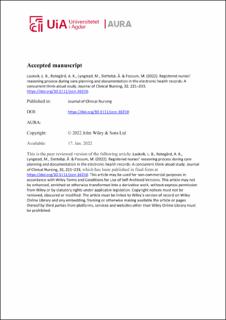| dc.contributor.author | Laukvik, Lene Baagøe | |
| dc.contributor.author | Rotegård, Ann Kristin | |
| dc.contributor.author | Lyngstad, Merete | |
| dc.contributor.author | Slettebø, Åshild | |
| dc.contributor.author | Fossum, Mariann | |
| dc.date.accessioned | 2024-04-26T06:07:56Z | |
| dc.date.available | 2024-04-26T06:07:56Z | |
| dc.date.created | 2022-02-07T10:11:10Z | |
| dc.date.issued | 2022 | |
| dc.identifier.citation | Laukvik, L. B., Rotegård, A. K., Lyngstad, M., Slettebø, Å. & Fossum, M. (2022). Registered nurses’ reasoning process during care planning and documentation in the electronic health records: A concurrent think-aloud study. Journal of Clinical Nursing (JCN), 32, p. 21–233. | en_US |
| dc.identifier.issn | 1365-2702 | |
| dc.identifier.uri | https://hdl.handle.net/11250/3128142 | |
| dc.description.abstract | Aims and objectives: To explore the clinical reasoning process of experienced reg-istered nurses during care planning and documentation of nursing in the electronic health records of residents in long-term dementia care.
Background: Clinical reasoning is an essential element in nursing practice. Registered nurses’ clinical reasoning process during the documentation of nursing care in elec-tronic health records has received little attention in nursing literature. Further re-search is needed to understand registered nurses’ clinical reasoning, especially for care planning and documentation of dementia care due to its complexity and a large amount of information collected.Design: A qualitative explorative design was used with a concurrent think-aloud technique.Methods: The transcribed verbalisations were analysed using protocol analysis with referring phrase, assertional and script analyses. Data were collected over ten months in 2019–2020 from 12 registered nurses in three nursing homes offering special de-mentia care. The COREQ checklist for qualitative studies was used.Results: The nurses primarily focused on assessments and interventions during documentation. Most registered nurses used their experience and heuristics when reasoning about the residents’ current health and well- being. They also used logi-cal thinking or followed local practice rules when reasoning about planned or imple-mented interventions.Conclusion: The registered nurses moved back and forth among all the elements in the nursing process. They used a variety of clinical reasoning attributes during care planning and nursing documentation. The most used clinical reasoning attributes were information processing, cognition and inference. The most focused information was planned and implemented interventions.Relevance to clinical practice: Knowledge of the clinical reasoning process of regis-tered nurses during care planning and documentation should be used in developing electronic health record systems that support the workflow of registered nurses and enhance their ability to disseminate relevant information. | en_US |
| dc.language.iso | eng | en_US |
| dc.publisher | Wiley | en_US |
| dc.rights | Attribution-NoDerivatives 4.0 Internasjonal | * |
| dc.rights.uri | http://creativecommons.org/licenses/by-nd/4.0/deed.no | * |
| dc.title | Registered nurses’ reasoning process during care planning and documentation in the electronic health records: A concurrent think-aloud study | en_US |
| dc.type | Peer reviewed | en_US |
| dc.type | Journal article | en_US |
| dc.description.version | acceptedVersion | en_US |
| dc.rights.holder | © 2022 John Wiley & Sons Ltd | en_US |
| dc.subject.nsi | VDP::Medisinske Fag: 700::Helsefag: 800::Sykepleievitenskap: 808 | en_US |
| dc.source.pagenumber | 21–233 | en_US |
| dc.source.volume | 32 | en_US |
| dc.source.journal | Journal of Clinical Nursing (JCN) | en_US |
| dc.identifier.doi | https://doi.org/10.1111/jocn.16210 | |
| dc.identifier.cristin | 1998409 | |
| cristin.qualitycode | 2 | |

